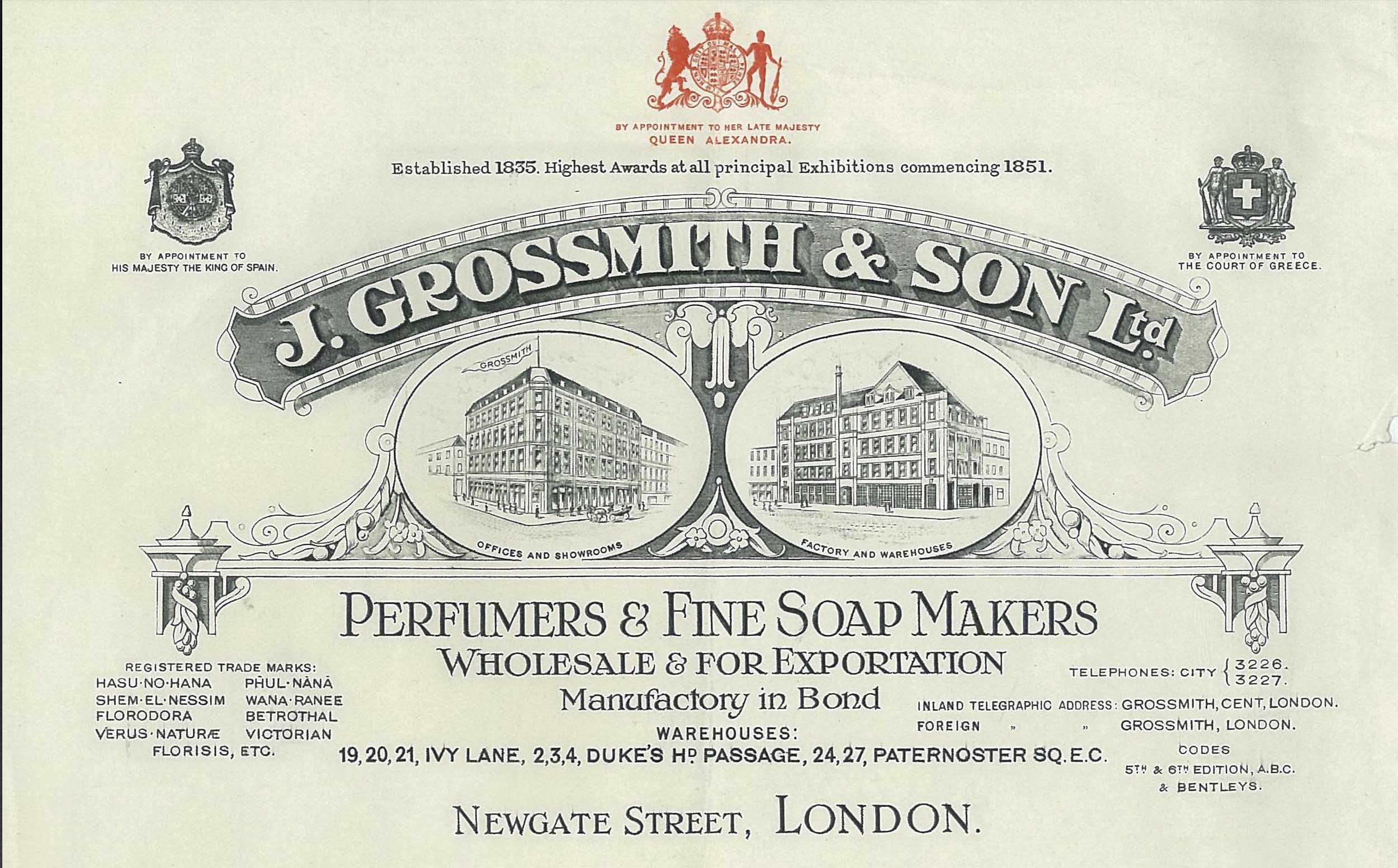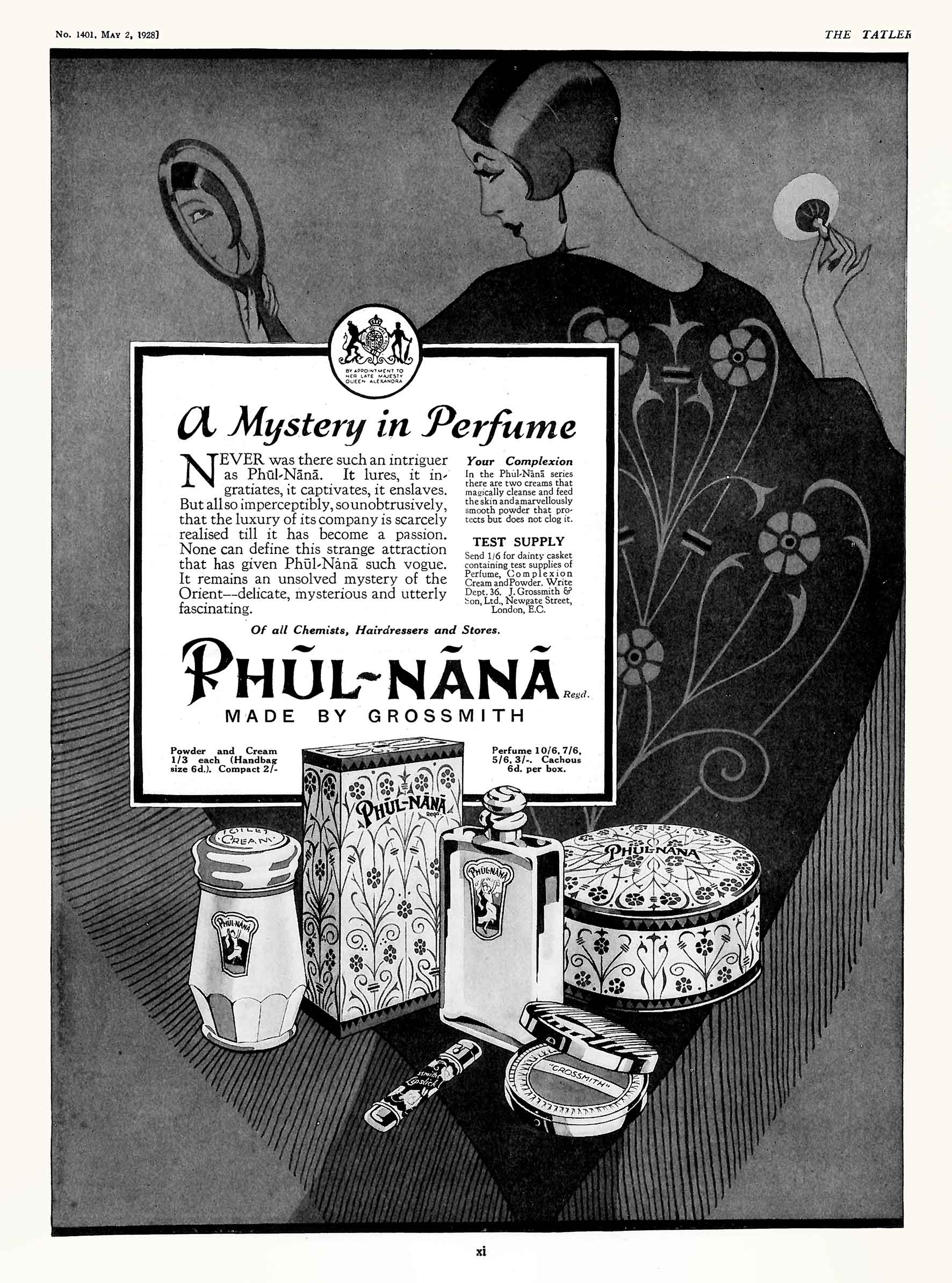Heritage: J.Grossmith & Son
ESTABLISHED IN 1835
Grossmith is one of England’s longest established perfume houses, founded in the City of London in 1835 by John Grossmith. John’s son, John Lipscomb Grossmith developed the firm into an influential, famous perfume house, manufacturing a wide range of perfumes, essential oils, fine soaps, face powders and many toiletries including hand creams.
In the early 1900s Grossmith formula books contained formulae for over 300 different products. Grossmith became a titan of the industry thanks to John Lipscomb Grossmith’s innovative creativity and progressive marketing. With a factory in Grasse at this time, Grossmith was more than a match for the very best French perfume houses.
Letterhead from 1930s
Grossmith’s factory at 29 Newgate Street was known as ‘The Laboratory of Flowers'.
Photograph from the Review of Reviews, 1903
creative perfumery
As ocean liners and railways opened up the world, a fascination with exploration and travel became fashionable.
In response to this, John Lipscomb Grossmith’s creations were designed to evoke travel and to transport the wearer in their imagination. They were rich and complex floral ambers, among the first fragrances to go beyond the market of the time for single florals – this was the dawn of creative perfumery.
Hasu-no-Hana, Shem-el-Nessim and Phul-Nana from the Grossmith Archives
At the Great Exhibition in 1851 J. Grossmith & Son was the only English company to win a prize medal for essential oils and perfumery.
Medals awarded to Grossmith for excellence in perfumery. Great Exhibition medal in centre
Grossmith display at the Brussels International Exhibition 1897
Phul-Nana, launched in 1891, was one of Britain’s most successful and popular fragrances in the 20th Century.
ROYAL ASSOCIATIONS
Grossmith has a long tradition of celebrating royal events. Grossmith was patronised by three generations of Royalty – Queen Victoria, King Edward VII and Queen Alexandra and Queen Mary.
In 1895 a bottle of Phul-Nana was presented to the Princess of Wales, who became Queen Alexandra, at the Orient Exhibition held at Olympia.
John Lipscomb Grossmith hosted a visit by King Edward VII to Grossmith’s premises in Grasse in 1903.
The Royal Courts of Greece and Spain as well as Queen Alexandra awarded Royal Warrants to Grossmith in the 1920s.
In 1897 Victorian Bouquet recognised Queen Victoria’s Diamond Jubilee
Advertisement for Victorian Bouquet, 1897
Advertisement for Betrothal, 1893
Regal logo, 1902
To mark the marriage of the Duke of York and Princess May (who later became King George V and Queen Mary) in 1893 Grossmith created Betrothal. The fragrance received official royal endorsement and bottles were labelled ‘by Gracious Permission of HRH Princess May’.
To celebrate Queen Victoria’s Diamond Jubilee in 1897, Grossmith created Victorian Bouquet, ‘The National Perfume’.
In 1902 Grossmith launched ‘Regal’ to mark the Coronation of King Edward VII – ‘truly a royal perfume’.
Archive
Now back in family ownership, the story continues to evolve. Many people connected with Grossmith’s past have contacted us and generously shared their memories and occasional artefacts, further enriching Grossmith’s virtual and physical archive. We in turn would like to share a selection of images from our archive.
Different aspects of our heritage packaging have inspired the design of our modern products, for example, the surlyn lozenges on the Classic and Royal caps.
Grossmith glass bottles with glass stoppers advertised in 1906.
The standard oval perfume bottle, used by many houses back in the mid to late 1800s, had a ground glass stopper which bore a lozenge to make opening and closing possible. Grossmith sought to add interest and a distinguishing feature to the presentation of their perfumes with their labelling, silk and ribbons, and the stopper lozenge. The image above shows three Grossmith bottles with decorative lozenges which were being advertised in 1906.
Grossmith Baccarat Flacon base forming the ‘Grossmith octagon’
A key motif of our modern design is a square with its corners cut off, the Grossmith octagon, derived from a horizontal section through our Baccarat flacon.
As a reminder that our Classic and Royal fragrances have been presented in Baccarat Crystal the lozenge on the modern overcap is the Grossmith octagonal shape. Our Black Label fragrances have not been presented in Baccarat crystal and we chose a different style of cap, without the lozenge but with GL embossed on the top.
Grossmith caps














